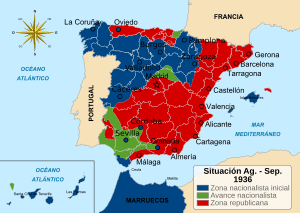Battle of Badajoz (1936) facts for kids
Quick facts for kids Battle of Badajoz |
|||||||
|---|---|---|---|---|---|---|---|
| Part of Spanish Civil War | |||||||
|
|||||||
| Belligerents | |||||||
| Commanders and leaders | |||||||
| Col. Ildefonso Puigdendolas | Lt. Col. Juan Yagüe Lt. Col. Carlos Asensio Lt. Col. Antonio Castejón |
||||||
| Units involved | |||||||
| 3rd Infantry Regiment Castile | Madrid Column | ||||||
| Strength | |||||||
| 6,000 4,000 2,000 militiamen, 500 soldiers up 2,000 some bombers |
3,000 regulars 30 guns at least four bombers |
||||||
| Casualties and losses | |||||||
| 750 dead 3,500 wounded, captured or missing |
185 casualties: 44 dead, 141 wounded |
||||||
The Battle of Badajoz was an important fight early in the Spanish Civil War. It happened on August 14, 1936. Nationalist forces attacked and captured the city of Badajoz. This victory was very important for them. It helped them connect their forces in the north and south of Spain. It also cut off the Republic from Portugal.
Contents
Why Badajoz Was Important
The Spanish Civil War began on July 19, 1936. It started when a group of military officers tried to take control of the country. This attempt did not fully succeed. The rebels controlled about one-third of Spain.
One of the main rebel leaders was Francisco Franco. He was in charge of forces in Morocco. His first move was to get help from Germany and Italy. These countries sent planes to help transport nearly 10,000 soldiers. These soldiers were part of the Spanish Army of Africa. They were moved across the Straits of Gibraltar to southern Spain.
By August 1, General Franco ordered his troops to move north. Their goal was to connect with General Emilio Mola's forces in the north. The Nationalist army moved quickly. They captured many towns along the way. By August 10, they reached Mérida. After a tough fight, Mérida fell. This left Badajoz as the last Republican city near the Portuguese border. Franco wanted to capture Badajoz. This would link his forces and protect his army's side along the border.
Who Fought in Badajoz?
The Nationalist forces were led by Lieutenant Colonel Juan Yagüe. He had about 2,250 soldiers from the Spanish Foreign Legion. He also had 750 Moroccan regulares. They brought 30 large guns for the attack.
Inside Badajoz, the city was old and had strong walls. However, some parts of the walls had been taken down before the war. Many people had fled to Badajoz, making the city crowded. The people there felt worried and knew an attack was coming.
The Republican forces were led by Colonel Ildefonso Puigdendolas. He had between 2,000 and 6,000 militia members. A few days before the battle, some local police tried to join the rebels. Colonel Puigdendolas stopped this revolt. But it made his forces weaker and lowered their spirits.
The Battle Begins
Before the main attack, Nationalist artillery and planes bombed Badajoz for three days. The rebels attacked on the morning of August 14. They shelled the city again before moving in. Colonel Puigdendolas, the mayor, and other leaders left the city around 9:00 AM. They fled to Portugal.
On the south side of the city, Nationalist troops easily broke through the walls. Moroccan soldiers pushed through the Puerta de Los Carros (Car Gate). Other soldiers quickly took over the barracks. Many soldiers inside the city also switched sides. This made it easier for the attackers to enter.
The toughest fight was at the Puerta de la Trinidad (Trinity Gate). Republican machine gunners and riflemen fought hard there. They stopped several waves of attacking soldiers. But the Nationalist Legionnaires kept pushing forward. Armored cars helped them break through the gate. The Nationalists then fought hand-to-hand with the defenders. This part of the battle was very costly for the attackers. One company lost most of its soldiers and officers.
Once inside the city, the Nationalist soldiers pushed the Republican militia back. Street fighting continued late into the night.
After the Battle
The Battle of Badajoz caused a delay for the Nationalist army. This delay gave the Republican government time to prepare its defenses around Madrid.
After the battle, the Republic lost control of the large region of Extremadura. This area was then taken over by the Nationalist state. Yagüe's forces then turned northeast. They headed towards Madrid and the Tagus River. They fought more battles in the weeks that followed.
The Battle of Badajoz showed a pattern of the war. Republican militia often held old fortresses. But they could not stop Franco's well-trained and better-equipped troops. The professional Spanish regular army could break through strong defenses. However, they often lost many of their best soldiers. By the end of the year, many of the Spanish Foreign Legion soldiers had died. They were lost in battles across many towns from Seville to Madrid.
Massacre of Civilians
After the city fell, it was widely reported that Nationalist forces killed many prisoners and civilians. This included a large number of executions in the city's bullring.
Many people witnessed these events. Foreign reporters like Jay Allen and Mário Neves wrote about them. Photographs also exist. Today, most historians agree that thousands of militia members and civilians were killed. Many of the victims were ordinary workers and farmers. This event became known as Franco's White Terror.
See also
 In Spanish: Batalla de Badajoz (1936) para niños
In Spanish: Batalla de Badajoz (1936) para niños
- List of Spanish Nationalist military equipment of the Spanish Civil War
- List of Spanish Republican military equipment of the Spanish Civil War
- Badajoz bastioned enclosure


